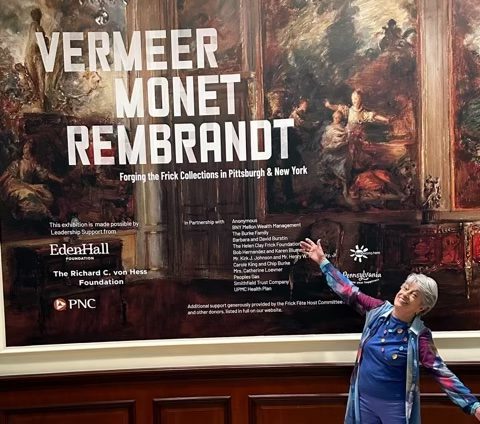The headlines tout the value of the not-to-be-missed art exhibit, “Pittsburgh Meets New York at The Frick Art Museum.” The Frick is smaller than the Carnegie, built on the property of the Frick family home where they lived before moving to New York. The purchases for this art collection were made during the time when 80 to 90 percent of the wealth in this country was in the hands of a few men. The conflictual relationship between the two gilded-age robber barons who founded Pittsburgh’s two art institutions is well known and you could wonder if the competition between them lives on in the collections of art they amassed along with the power and money it took to acquire the Old Masters.
If we ask the question what makes a painting or work of art an old master, reuniting the collections of 19th-century industrialist Henry Clay Frick and his daughter, philanthropist Helen Clay Frick highlighted for me one of the forces that created the reverence for the Old Masters in the first place. Henry bought art from the collections of the powerful men who came before him, who likely purchased it from the powerful men before them. The building of museums was about providing access to art for the communities’ good, but these men determined what was noteworthy enough to pass down. In the European art that came before 1800, one man gets the credit for its creation and the owner of the masterpiece gets the respect and gravitas associated with what the art experts have determined to be “the best of the best.”
The business of art often doesn’t benefit the artists themselves in their own lifetime. It’s common knowledge that many of the artists whose names are well-known today suffered financial hardship throughout their lives. This may be what’s behind parents’ reluctance to see their offspring go into art without “a real job” to support their art habit or hobby. I was surprised by the elaborate self portrait of Rembrandt dressed in the accruements of an extremely wealthy man that the program notes stated was painted during a time when he was suffering extreme financial difficulty.
The collection of Frick’s devoted daughter Helen reveals a fact not often recognized – the reality of art making in the past and to this day is that art pieces are often made in and by an art collective. Assistants are taught and supervised by the lead artist who is given credit for having authored the work. Many of the pieces in Helen’s collection were not only smaller and more intimate than her father’s art selections and more feminine in subject matter, but there were often controversies over who the actual artist was since many came from artist’s workshops. The practice and use of assistants in artist’s workshops was widespread through the ages and is still integral to the practice of art creation today. My husband and I learned this from two artists Walker and Moore, who met when their booths were side by side at a street fair. They became a married couple and soon connected their creative artwork by both taking turns painting on the same canvas. The work was done when both artists were satisfied with the outcome. We purchased several of their pieces to display in our behavioral health care clinic. Besides admiring their finished products, we admired the path they took to get there. We hoped their works could serve as inspiration and encouragement to those clients working on improving their own family collaborations.
The Frick Museum’s epilogue statement seems to support the collective and collaborative nature of valuing art and artmaking. “Today, museums strive to be centers of creativity, thought, and conversation, rather than temples of objects chosen by (and to represent) an elite few.”




